This year, Jacob’s Pillow’s home state of Massachusetts celebrates its 250th anniversary and the anniversary of American Independence. While the state is recognized as the birthplace of American liberty, it has also been a source of artistic innovation, home to some of the country’s earliest creative movements—and to the first dance festival in the United States that still runs today.
To mark this historic moment, we’re highlighting Pillow Firsts: moments when Jacob’s Pillow intersected with major milestones in American history, commemorating a landmark moment for both the dance world and the nation.
1933: On July 14, Jacob’s Pillow became the first dance festival established in the United States that continues today.
In what is now known as the Tea Garden and the Bakalar Studio, Ted Shawn and the Men Dancers gave their first “tea-dance” performance on July 14, 1933 to an audience of fifty-seven people, marking the beginning of the Jacob’s Pillow Dance Festival. This performance also commemorates the first company of men dancers in modern times, with Ted Shawn’s Men Dancers serving as the pioneering force that established dance as a serious artistic pursuit for men.
The dancers served tea to the audience before moving into the barn turned studio for an informal lecture by Ted Shawn followed by a performance of two group dances and two solos by Shawn. This extremely rare film fragment represents the earliest moving image of the Men Dancers in their first performed work, recorded just months after their debut.
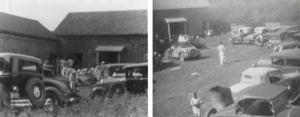
1942: The Ted Shawn Theatre, named after the Pillow’s founder Ted Shawn, becomes the first theater in the country to be built specifically for dance.
On July 9, 1942 the Ted Shawn Theatre opened its doors, making it the first performance space in the country designed specifically for dance. Designed by Architect Joseph Franz, who also built Tanglewood’s Music Shed, the theater’s exterior and post-and-beam construction were created to harmonize with the existing farmhouse and barns, giving the theater its iconic look. The rooftop weathervane, also designed by Franz, depicts Barton Mumaw, Shawn’s leading dancer and partner.
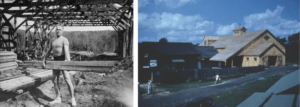
1942: Asadata Dafora, the first artist to stage West African Dance for the concert stage, dances in the first season of the Ted Shawn Theatre.
In his essay on Jacob’s Pillow Dance Interactive, John Perperner writes that Asadata Dafora, born in Sierra Leone in 1890, “became known in this country as the first to present authentic African music and dance in a theatrical setting.” With his first performances taking place in Harlem in the 1930s, Dafora performed with one of his dancers, Randolph Sawyer, in the Ted Shawn Theatre’s inaugural season in August of 1942. The two dancers performed alternating solos which introduced Pillow audiences to the distinctive elements of West African dance.
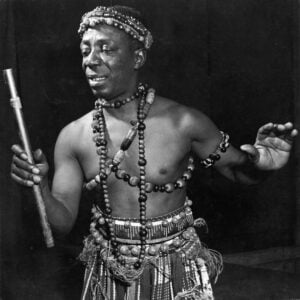
1961: Alvin Ailey’s Revelations was presented at Jacob’s Pillow for the first time in its present form.
During the company’s second visit to the Festival in July of 1961, Alvin Ailey presented his most iconic work, Revelations, for the first time in the format that it is known for today. With the original version running over an hour, Ailey refined the work for the company’s 1961 performances, including the debut of the seminal solo I Wanna Be Ready, based on the teachings of Ailey’s mentor, Lester Horton.
This summer, Alvin Ailey American Dance Theatre returns to Jacob’s Pillow with its full company for the first time in 62 years, performing Revelations as it was first seen in 1961.
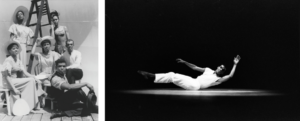
1962: Balasaraswati, one of India’s most famous and revered dancers, made her first United States appearance at Jacob’s Pillow.
Credited with cultivating international appreciation for the Indian courtly dance form Bharatanatyam, Tanjore Balasaraswati, or Balasaraswati, gave her first United States performance at Jacob’s Pillow in August of 1962, the Festival’s 30th anniversary. Hari Krishnan writes that after Bharatanatyam was suppressed in late-nineteenth century India by the Western ethics of colonialism, Balasaraswati emerged as one of its few performers “who managed to carve a livelihood for herself despite the challenges of such social stigma and marginalization.”
Balasaraswati’s performance at Jacob’s Pillow opened a new era in the propagation of her art, a unique integration of the rich musical tradition of Bharatanatyam and her own creative efforts. Balasaraswati would continue her artistic relationship with the Pillow until 1979, a few years before her death. Her daughter Lakshmi, son-in-law Douglas Knight, and grandson Aniruddha Knight would continue this relationship into the 21st century.
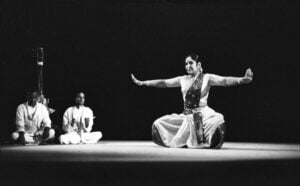
1970: The first professional appearances by Dance Theatre of Harlem occur at Jacob’s Pillow.
Dance Theatre of Harlem, founded by former New York City Ballet dancer Arthur Mitchell in 1969, gave their first performances for a paying, concert-going audience at Jacob’s Pillow in August of 1970. The company would go on to become the first predominantly-Black ballet company to garner national and international acclaim, performing at the Festival several times throughout its history, with their most recent appearance in Festival 2024.

2000: Jacob’s Pillow is included in the list of America’s Irreplaceable Dance Treasures: the First 100, selected by the Dance Heritage Coalition.
In 2000, the Dance Heritage Coalition sought to heighten public interest and celebrate the magnificence and richness of America’s dance heritage. Out of over 900 nominations, Jacob’s Pillow was selected as one of the First 100 of America’s Irreplaceable Dance Treasures, recognizing its significant impact on dance as an art form, and the enriching effect it has had on the nation’s cultural heritage. To celebrate the First 100, the Dance Heritage Coalition created an exhibit which toured nationally from 2003 to 2009.
2003: Jacob’s Pillow is designated as a National Historic Landmark, the first and only dance site chosen by the federal government.
Following its listing on the National Register of Historic Places in 2001, the first property to be listed because of its importance as a dance institution, Jacob’s Pillow was designated as a National Historic Landmark in 2003, distinguishing it as a place that possesses “meaning for all Americans,” and the first and only Landmark dance institution to be named to this day.
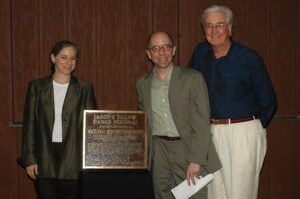
2011: Jacob’s Pillow becomes the first dance presenting organization to receive the National Medal of the Arts.
In 2011, Jacob’s Pillow was awarded the National Medal of the Arts, presented by President Barack Obama at The White House. The Pillow is not only the first dance presenting organization to receive the medal, but also the first institution in all of Massachusetts to be selected for this prestigious national honor, primarily given to individuals.